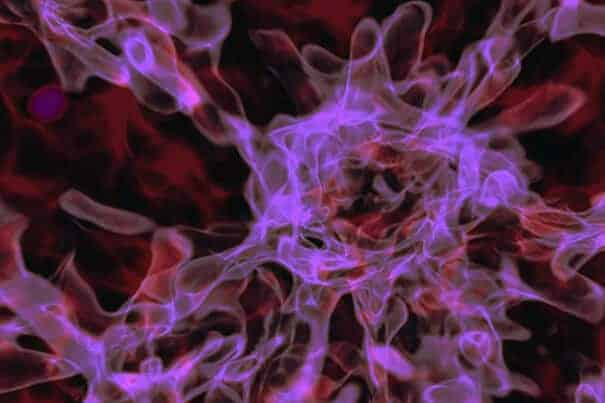Astronomers Aaron Smith and Volker Bromm of the University of Texas at Austin, working with Avi Loeb of the Harvard-Smithsonian Center for Astrophysics, have discovered evidence for an unusual kind of black hole born extremely early in the universe. In new research they show that a recently discovered source of intense radiation is likely powered by a “direct-collapse black hole,” a phenomenon predicted by theorists more than a decade ago.
The work was published this month in the journal Monthly Notices of the Royal Astronomical Society.
“It’s a cosmic miracle,” Bromm said, referring to the precise set of conditions present half a billion years after the Big Bang that allowed the behemoths to emerge. “It’s the only time in the history of the universe when conditions are just right” for them to form.
Direct-collapse black holes also may be the solution to a long-standing puzzle in astronomy: How did supermassive black holes form in the early epochs of the universe? There is strong evidence for their existence, as they are needed to power the highly luminous quasars detected in the young universe. However, there are several problems preventing their formation, and the conventional growth process is much too slow.
Astronomers think they know how supermassive black holes weighing in at millions of suns grow in the heart of most galaxies in our epoch. They start from a “seed” black hole, created when an extremely massive star collapses. The seed black hole has the mass of about 100 suns. It pulls in gas from its surroundings, becoming much bigger, and eventually may merge with other seed black holes. The process is called accretion.
The accretion theory does not explain supermassive black holes in extremely distant — and therefore young — quasars. The incredible brightness of quasars, visible across billions of lightyears, comes from matter spiraling into a supermassive black hole, creating jets that shine as beacons across the universe.
These early galaxies may have contained the first generation of stars created after the Big Bang. And although these stars can collapse to form black holes, they don’t work as early quasar seeds. There is no surrounding gas for the black hole to feed on. That gas has been blown away by winds from the hot, newly formed stars.
“Star formation is the enemy of forming massive black holes” in early galaxies, Bromm said. “Stars produce feedback that blows away the surrounding gas cloud.”
For decades, astronomers have called this conundrum “the quasar seed problem.”
Thirteen years ago, Bromm and Loeb came up with an idea to get an early galaxy to form a supermassive seed black hole, by suppressing the otherwise prohibitive energy input from star formation. Astronomers later dubbed this process “direct collapse.”
Begin with a “primordial cloud of hydrogen and helium, suffused in a sea of ultraviolet radiation,” Bromm said. “You crunch this cloud in the gravitational field of a dark matter halo. Normally, the cloud would be able to cool, and fragment to form stars. However, the ultraviolet photons keep the gas hot, thus suppressing any star formation. These are the desired, near-miraculous conditions: collapse without fragmentation! As the gas gets more and more compact, eventually you have the conditions for a massive black hole.”
This set of cosmic conditions is exquisitely sensitive to the time period in the universe’s history — the process does not happen in galaxies today.
If our reporting has informed or inspired you, please consider making a donation. Every contribution, no matter the size, empowers us to continue delivering accurate, engaging, and trustworthy science and medical news. Independent journalism requires time, effort, and resources—your support ensures we can keep uncovering the stories that matter most to you.
Join us in making knowledge accessible and impactful. Thank you for standing with us!

